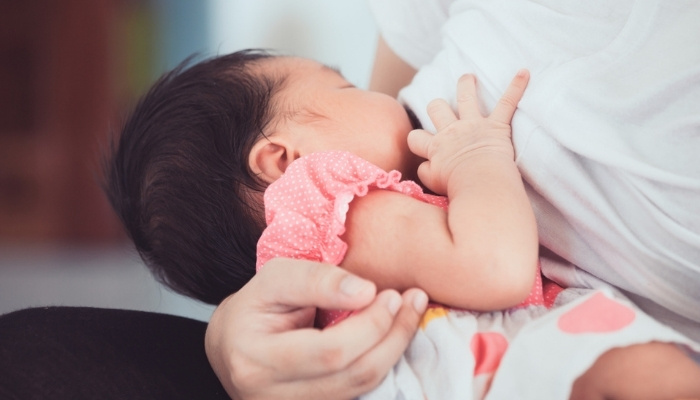Some nursing mothers may not see a difference in milk supply between their breasts, while others may have one breast that appears smaller than the other.
What is slacker boob? Slacker boob is when one breast produces less milk than the other due to differing milk-making tissues or baby’s preference. If your baby is getting enough milk and is healthy, you don’t have to fix your slacker boob. However, you can even out your breasts through pumping and extra feedings.
Read on to learn more about how to fix slacker boob.
Slacker Boob – What To Know
Whether you need to even out your breasts or prevent them from becoming uneven, you likely have questions. Let’s dive in.
How Breasts Produce Milk
Breasts produce milk through demand from the baby, whether through nursing or pumping. Nipple stimulation from your baby’s suckling or pumping signals the brain to release prolactin and oxytocin.
Prolactin causes the alveoli to make milk, while oxytocin causes the muscles around the alveoli to squeeze the milk through the milk ducts.
Factors That Affect the Quantity of Breast Milk
These factors affect the quantity of breast milk your body makes:
- Waiting too long to start breastfeeding.
- Breastfeeding too infrequently.
- Premature birth.
- A poor latch.
- High blood pressure from pregnancy.
- Using certain medications.
- Maternal obesity.
Why One Breast May Produce Less Milk
One breast may produce less milk for the following reasons:
- One breast has more milk-making tissue than the other.
- One breast has a more forceful let-down.
- One breast is in a more comfortable position for your baby than the other.
- You may pick one breast over the other without realizing it.
Uneven Milk Supply When Breastfeeding
When breastfeeding, you may have an uneven milk supply because your baby takes more milk from one breast than the other. In that case, you should offer the slacker boob more often during feedings.
Try starting with the slacker boob, switching to the dominant breast, and ending with the slacker boob.
One Breast Produces More Milk Than the Other When Pumping
You may also notice that one breast produces more milk than the other when pumping. This phenomenon may happen because of the difference in mammary tissue in each breast.
In that case, it helps to pump on the slacker breast for longer.
How To Avoid Uneven Milk Supply – 3 Tips
If you want to keep your milk supply up in both breasts, follow these tips.
1. Alternate Breasts When Nursing
Since your body makes milk on demand, always offer both breasts when nursing. Feed your baby until your breast is soft, and then move to the next breast.
At the next feeding, offer the breast you finished with the last time first. If your baby only nurses from one breast per feeding, start with the other breast at the next feeding.
2. Offer Different Nursing Positions
Your baby might prefer one breast over the other because it’s more comfortable. Start nursing on the preferred breast, then switch them to the other while in the same position. You can also try another way to hold your baby.
Some common breastfeeding positions include:
- Reclined breastfeeding: The baby faces you while you recline.
- Cradle hold: The baby’s belly is facing you, and you’re sitting upright.
- Football hold: The baby is aligned with the side of your body.
- Side-lying nursing: You and the baby are lying side-by-side on the bed.
- Upright breastfeeding: You and your baby are sitting up.
3. Remember Your Over-Producing Breast
Even though you’re trying to increase milk supply in your slacker boob, you shouldn’t neglect the breast your baby prefers. Going too long without emptying your breasts can lead to clogged milk ducts and mastitis.
Continue feeding your baby with your over-producing breast as usual while pumping and nursing extra on the slacker boob.

Slacker Boob Solutions When Breastfeeding
When breastfeeding, you can correct slacker boob by:
- Offering the slacker boob first: When your baby first starts feeding, they’re hungry and likely to suck more strongly. After your baby has adequately sucked on the slacker boob, you can offer the preferred breast to make sure they get enough milk.
- Pumping the slacker boob after a feeding: After feeding your baby from both breasts, pump the slacker boob for at least a few minutes. Pumping will tell your body that it needs to produce more milk.
- Drinking more water: Breastfeeding women should drink about 16 8-ounce cups of water to maintain their supply. If you don’t like water, try adding some lemon to give it flavor.
- Applying heat to the slacker boob: Heat can promote breast milk production and help relax your muscles. Take a warm shower or put a heating pad on the slacker boob before a feeding.
How To Increase Milk Supply in One Breast Exclusively Pumping
If you’re exclusively pumping, you can increase the milk supply in one breast by pumping extra. Pump the side you need to improve between feedings to start seeing an improvement.
For example, if you pump both breasts every two hours, pump the slacker boob every hour. Once you see an increase in the milk in the slacker boob, you can stop pumping as much until the issue comes back.
What Is Power Pumping Breastfeeding?
Power pumping is a method resembling cluster feeding, which is when babies nurse at shorter, more frequent sessions to encourage the mother to produce more milk.
To power pump, pump for 20 minutes, rest for 10 minutes, and continue until you’ve been pumping for 60 minutes.
Pros and Cons of Power Pumping
Power pumping is beneficial because it:
- Helps baby with a difficult latch.
- Helps moms who exclusively pump.
- Is flexible, so you can pump shorter sessions.
However, keep in mind that it:
- Takes a lot of work.
- May be better for nursing moms to nurse more frequently.
- Is not a long-term solution for milk supply.
Cluster Pumping vs. Power Pumping
Cluster pumping is like power pumping but not as consistent. Cluster feeding typically happens during a baby’s growth spurt, when the baby takes in more milk more frequently.
The purpose of cluster pumping is to encourage the production of prolactin and to keep the breasts empty so the body continues making milk. Since power pumping is more scheduled, it’s more manageable than cluster pumping.
Power Pumping Results
If you power pump, you’ll usually see an increase in your breast milk supply after two or three days. Some mothers claim that it takes between four and seven days.
No matter how long it takes you to notice your milk coming in more fully, stop the power-pumping sessions once your breasts are even.
Breast Compressions
If you have one breast that’s producing more milk than the other, you may want to use breast compressions to even everything out.
What Are Breast Compressions?
Breast compressions involve gently squeezing the breasts to help create a stronger flow of milk for your baby.
This stronger flow keeps your baby interested in nursing or pumping so they continue to suckle, thus encouraging your breasts to produce more milk.
Breast Compressions While Nursing
Breast compressions can be an excellent way to increase your slacker side while nursing instead of pulling out the pump.
After putting your baby in a comfortable position and letting them suckle for a few minutes, use a circular massage to stimulate the milk ducts from the armpit area to the breast.
Whenever your baby starts to slow down or fall asleep, support your breast with your four fingers and push the milk out of the breast with your thumb.
Breast Compressions Pumping
Breast compressions help when the mother is exclusively pumping. To do breast compressions while pumping, you may want to use a hands-free pump so you can massage your breast while extracting the milk with the pump.
Before pumping, prime your breast with a circular massage or a heated pad. While you’re pumping with one hand, use the other hand to massage and compress the breast to encourage more milk output.
Related Questions:
Which Breast Produces More Milk?
Recent studies show that the right breast produces much more milk than the left breast, especially when it comes to pumping.
However, because milk is made based on what your baby needs, your left breast might produce more milk if your baby prefers your left breast.
Why Does One Breast Hurt While Breastfeeding?
One breast might hurt while breastfeeding because of engorgement or a clogged duct. If you don’t empty your breasts of milk enough, they become too full.
In some cases, a duct could get clogged and you could develop an infection. This tends to happen if your baby prefers one breast over the other.
Conclusion
Uneven breasts while breastfeeding is a common issue. As long as your baby is eating enough and gaining weight properly, you don’t have to fix it.
However, if there’s a noticeable difference in breast size, even them out through power pumping and extra feedings.
Sources:
- https://www.verywellfamily.com/what-to-do-if-one-breast-makes-more-milk-than-the-other-5201586
- https://kidshealth.org/en/parents/breastfeed-supply.html
- https://www.mamaoffive.com/how-to-increase-breastmilk-in-a-slacker-boob/
- https://www.medela.us/breastfeeding/articles/uneven-supply-less-milk-production-in-one-breast
- https://themamanurse.com/power-pumping-schedule/
- https://www.genuinelactation.com/blog-for-breastfeeding-families/power-pumping-and-cluster-pumping
- https://www.breastfeeding.asn.au/resources/breast-compressions
- https://www.nhs.uk/conditions/baby/breastfeeding-and-bottle-feeding/breastfeeding-problems/breast-pain/
- https://motifmedical.com/blog/breast-compression-and-why-it-helps
Mom of three (including identical twin boys), wife, and owner of Parents Wonder. This is my place to share my journey as a mother and the helpful insights I learn along the way.

